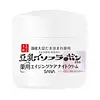What's inside
What's inside
 Key Ingredients
Key Ingredients

 Benefits
Benefits

 Concerns
Concerns

 Ingredients Side-by-side
Ingredients Side-by-side

Niacinamide
SmoothingWater
Skin ConditioningButylene Glycol
HumectantGlycerin
HumectantSqualane
EmollientOctyldodecyl Myristate
EmollientPEG-8 Dimethicone
EmulsifyingBatyl Alcohol
EmollientHydrogenated Egg Oil
Skin ConditioningStearic Acid
CleansingPolyglyceryl-2 Distearate
EmulsifyingGlyceryl Isostearate
EmollientDipentaerythrityl Hexa C5-9 Acid Esters
Skin ConditioningBehenyl Alcohol
EmollientLactobacillus/Soymilk Ferment Filtrate
Skin ConditioningRetinol
Skin ConditioningN-Stearoyl-Dihydrosphingosine
Skin ConditioningCyclodextrin
AbsorbentAlcohol Denat.
AntimicrobialPolyvinylalcohol Crosspolymer
Buttermilk Extract Powder
AntioxidantXanthan Gum
EmulsifyingBifida Polysaccharide
HumectantGlycine Soja Extract
Skin ConditioningTrimethylpyrazine
PerfumingPhytosterols
Skin ConditioningGlyceryl Myristate
EmollientPolysorbate 20
EmulsifyingPotassium Hydroxide
BufferingSodium Hydroxide
BufferingHydrogenated Phosphatidylcholine
EmulsifyingPhenoxyethanol
PreservativeNiacinamide, Water, Butylene Glycol, Glycerin, Squalane, Octyldodecyl Myristate, PEG-8 Dimethicone, Batyl Alcohol, Hydrogenated Egg Oil, Stearic Acid, Polyglyceryl-2 Distearate, Glyceryl Isostearate, Dipentaerythrityl Hexa C5-9 Acid Esters, Behenyl Alcohol, Lactobacillus/Soymilk Ferment Filtrate, Retinol, N-Stearoyl-Dihydrosphingosine, Cyclodextrin, Alcohol Denat., Polyvinylalcohol Crosspolymer, Buttermilk Extract Powder, Xanthan Gum, Bifida Polysaccharide, Glycine Soja Extract, Trimethylpyrazine, Phytosterols, Glyceryl Myristate, Polysorbate 20, Potassium Hydroxide, Sodium Hydroxide, Hydrogenated Phosphatidylcholine, Phenoxyethanol
Water
Skin ConditioningGlycerin
HumectantDipropylene Glycol
HumectantCetyl Ethylhexanoate
EmollientPentylene Glycol
Skin ConditioningDiglycerin
HumectantTrehalose
HumectantPEG-60 Hydrogenated Castor Oil
EmulsifyingGalactomyces/Milk Ferment Filtrate
HumectantGlycine Soja Seed Extract
Skin ConditioningGlycine Soja Protein
EmulsifyingPEG-240/Hdi Copolymer Bis-Decyltetradeceth-20 Ether
StabilisingAcrylates/C10-30 Alkyl Acrylate Crosspolymer
Emulsion StabilisingButylene Glycol
HumectantPEG-32
HumectantAlcohol
AntimicrobialEthylhexylglycerin
Skin ConditioningGlycyrrhiza Glabra Root Extract
BleachingDiphenylsiloxy Phenyl Trimethicone
Skin ConditioningDimethicone
EmollientSodium Stearoyl Glutamate
CleansingTocopherol
AntioxidantTriethylhexanoin
MaskingBehenyl Alcohol
EmollientPentasodium Pentetate
Sodium Hydroxide
BufferingPhenoxyethanol
PreservativeWater, Glycerin, Dipropylene Glycol, Cetyl Ethylhexanoate, Pentylene Glycol, Diglycerin, Trehalose, PEG-60 Hydrogenated Castor Oil, Galactomyces/Milk Ferment Filtrate, Glycine Soja Seed Extract, Glycine Soja Protein, PEG-240/Hdi Copolymer Bis-Decyltetradeceth-20 Ether, Acrylates/C10-30 Alkyl Acrylate Crosspolymer, Butylene Glycol, PEG-32, Alcohol, Ethylhexylglycerin, Glycyrrhiza Glabra Root Extract, Diphenylsiloxy Phenyl Trimethicone, Dimethicone, Sodium Stearoyl Glutamate, Tocopherol, Triethylhexanoin, Behenyl Alcohol, Pentasodium Pentetate, Sodium Hydroxide, Phenoxyethanol
Ingredients Explained
These ingredients are found in both products.
Ingredients higher up in an ingredient list are typically present in a larger amount.
Behenyl Alcohol is a type of fatty alcohol (these are different from the drying, solvent alcohols).
Fatty Alcohols have hydrating properties and are most often used as an emollient or to thicken a product. They are usually derived from natural fats and oils; behenyl alcohol is derived from the fats of vegetable oils.
Emollients help keep your skin soft and hydrated by creating a film that traps moisture in.
In 2000, Behenyl Alcohol was approved by the US as medicine to reduce the duration of cold sores.
Learn more about Behenyl AlcoholButylene Glycol (or BG) is used within cosmetic products for a few different reasons:
Overall, Butylene Glycol is a safe and well-rounded ingredient that works well with other ingredients.
Though this ingredient works well with most skin types, some people with sensitive skin may experience a reaction such as allergic rashes, closed comedones, or itchiness.
Learn more about Butylene GlycolGlycerin is already naturally found in your skin. It helps moisturize and protect your skin.
A study from 2016 found glycerin to be more effective as a humectant than AHAs and hyaluronic acid.
As a humectant, it helps the skin stay hydrated by pulling moisture to your skin. The low molecular weight of glycerin allows it to pull moisture into the deeper layers of your skin.
Hydrated skin improves your skin barrier; Your skin barrier helps protect against irritants and bacteria.
Glycerin has also been found to have antimicrobial and antiviral properties. Due to these properties, glycerin is often used in wound and burn treatments.
In cosmetics, glycerin is usually derived from plants such as soybean or palm. However, it can also be sourced from animals, such as tallow or animal fat.
This ingredient is organic, colorless, odorless, and non-toxic.
Glycerin is the name for this ingredient in American English. British English uses Glycerol/Glycerine.
Learn more about GlycerinPhenoxyethanol is a preservative that has germicide, antimicrobial, and aromatic properties. Studies show that phenoxyethanol can prevent microbial growth. By itself, it has a scent that is similar to that of a rose.
It's often used in formulations along with Caprylyl Glycol to preserve the shelf life of products.
Sodium Hydroxide is also known as lye or caustic soda. It is used to adjust the pH of products; many ingredients require a specific pH to be effective.
In small amounts, sodium hydroxide is considered safe to use. However, large amounts may cause chemical burns due to its high alkaline.
Your skin has a natural pH and acid mantle. This acid mantle helps prevent harmful bacteria from breaking through. The acid mantle also helps keep your skin hydrated.
"Alkaline" refers to a high pH level. A low pH level would be considered acidic.
Learn more about Sodium HydroxideWater. It's the most common cosmetic ingredient of all. You'll usually see it at the top of ingredient lists, meaning that it makes up the largest part of the product.
So why is it so popular? Water most often acts as a solvent - this means that it helps dissolve other ingredients into the formulation.
You'll also recognize water as that liquid we all need to stay alive. If you see this, drink a glass of water. Stay hydrated!
Learn more about Water